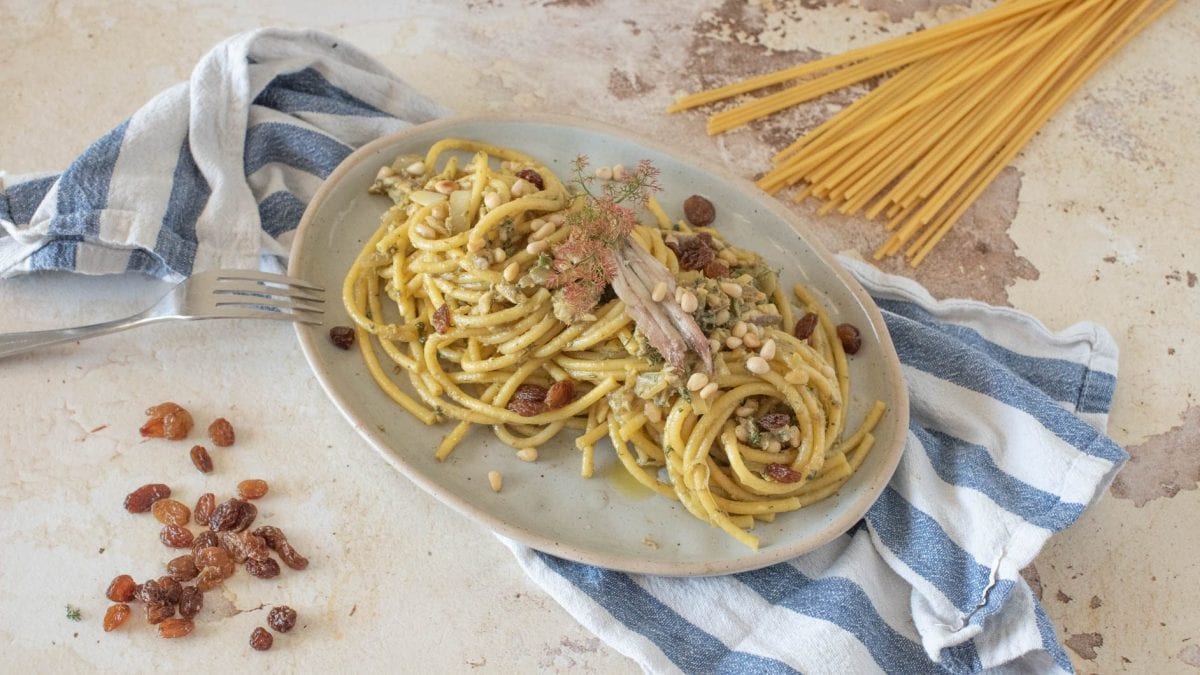
Sardine Pasta is a traditional Sicilian main dish, a dish where sea and land meet and which has become over time a true symbol of regional cuisine and in particular of the city of Palermo. In the original Palermo recipe, it is prepared by seasoning bucatini (or spaghetti) with sardines, wild fennel, raisins, pine nuts and saffron, which gives the pasta an intense yellow color. In some versions, toasted breadcrumbs are also added – muddica atturrata in dialect – flavored with tomato sauce. The result is a perfectly balanced dish, in which the flavor of the blue fish is enhanced by the intense aroma of the wild fennel and mitigated by the sweetness of the raisins.
Ideal to prepare in the period between March and September, when fresh fennel is available in the markets and sardines are sold at a low price, Sicilian pasta with sardines is quick and easy to prepare: the longest step is in fact cleaning the sardines, which however can be purchased already gutted at your local fishmonger. You will then simply need to sauté some onion in which to flavor the rest of the ingredients and, once cooked, cook the pasta in the sauce for a few minutes, so as to mix everything together.
What is Sicilian Sardine Pasta?
Pasta con le Sarde is more than just a traditional Sicilian dish—it's a flavorful symbol of the island's rich and layered history. Believed to have been created in the 9th century during Arab rule in Sicily, this dish is a fusion of Mediterranean ingredients that reflect Arab culinary influence. The use of wild fennel, pine nuts, raisins, and saffron highlights the spice trade routes and the diverse cultural footprint left on the island. According to legend, it was first prepared by an Arab chef in the port city of Mazara del Vallo to feed hungry troops using easily available ingredients—fresh sardines from the sea and wild herbs from the hills. Over time, the dish became a cornerstone of Sicilian cuisine, celebrated particularly in Palermo and Catania, each with its own twist.
Pro Tips for The Best Sicilian Sardine Pasta
- Fresh sardines are the heart of this dish. If you can, buy them whole and clean them yourself for the best flavor and texture. Frozen sardines can work in a pinch but make sure they're high quality.
- Wild fennel provides the dish's signature aroma and taste. If unavailable, a mix of fennel fronds and a pinch of fennel seeds can offer a decent substitute, but the wild version truly elevates the dish.
- The combination of raisins and pine nuts adds a delicate sweetness to the savory sardines. Soak the raisins in warm water or white wine before cooking to plump them up and deepen their flavor.
- Use bucatini or spaghetti and cook it until just al dente. This helps it hold up well when tossed with the rich, oily sauce and ingredients.
- Like many seafood dishes, Pasta con le Sarde is best enjoyed fresh. Serve it hot right after mixing all the components to preserve its texture and vibrant taste.
Can I Use Canned Sardines, Instead of Fresh Ones?
Yes, you can use canned sardines as a substitute if fresh ones aren’t available, but the flavor and texture will be slightly different. Opt for canned sardines in olive oil and drain them well before use. While they won't offer the same delicacy as fresh fish, they still provide a rich, savory taste that works well with the bold flavors of the dish. Just skip the step of cooking the sardines extensively, as they’re already cooked.
Can I Omit the Raisins?
Yes, you can omit the raisins if you prefer a less sweet flavor. While they add a traditional touch and a pleasant contrast to the savory sardines and wild fennel, the dish will still be delicious without them. For a slight tang, you could consider adding a splash of white wine or a few chopped cherry tomatoes instead.
Is This Pasta Spicy?
Traditionally, Pasta con le Sarde is not a spicy dish. Its flavor profile is more aromatic and sweet-savory, thanks to ingredients like wild fennel, raisins, pine nuts, and saffron. However, if you enjoy a bit of heat, you can add a pinch of red pepper flakes to the oil when sautéing the onions for a gentle kick that won’t overpower the original flavors.
Is There Anything Else I Could Add?
To add crunchiness to the dish, you can garnish it with tomato breadcrumbs: just blend 30 g of tomato puree, 40 g of extra virgin olive oil, half a clove of chopped garlic, fresh parsley, oregano and a pinch of chili pepper in a mixer and add the mixture to 150 g of breadcrumbs. Pass everything through a sieve to eliminate the humidity and finally toast the breadcrumbs in a pan and, once ready, distribute them on the pasta.
Can I Make This Ahead of Time?
You can prepare parts of Pasta con le Sarde ahead of time, but it's best enjoyed fresh. You can make the sauce a day in advance—just store it in an airtight container in the fridge. Avoid mixing the pasta and sauce too early, as it can become soggy. Also, toast the breadcrumbs just before serving to keep them crisp.
Does It Freeze Well?
Pasta con le Sarde doesn’t freeze particularly well, especially once the pasta is mixed with the sauce. The delicate texture of the sardines and the fennel can degrade, and the breadcrumbs will lose their crunch. However, you can freeze the sauce separately for up to one month. Just thaw it in the fridge and reheat gently before tossing with freshly cooked pasta and freshly toasted breadcrumbs for the best results.
How to Store Sicilian Sardine Pasta
To store leftovers of Pasta con le Sarde, place them in an airtight container and refrigerate for up to 2 days. Before storing, let the pasta cool to room temperature to avoid condensation. When reheating, warm it gently on the stove with a splash of water or olive oil to loosen the sauce.
Ingredients
How to Make Sicilian Sardine Pasta
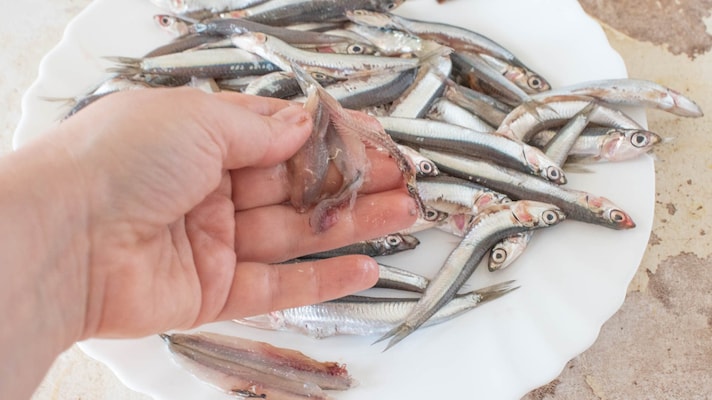
Start preparing the pasta with sardines by cleaning the fish: first remove the head, then open it like a booklet, remove the innards and bones and obtain three pieces from each fillet. Once cleaned, place the sardines in a bowl with water and ice and finally rinse them under cold running water, then pat them dry with kitchen paper.
Start preparing the pasta with sardines by cleaning the fish: first remove the head, then open it like a booklet, remove the innards and bones and obtain three pieces from each fillet. Once cleaned, place the sardines in a bowl with water and ice and finally rinse them under cold running water, then pat them dry with kitchen paper.

Then clean the fennel, cutting off the hardest parts of the stems, rinse it under cold running water and blanch it in 3 liters of boiling water for a few minutes. If you bought late fennel, let it cook for about ten minutes, otherwise 4-5 will be enough.
Then clean the fennel, cutting off the hardest parts of the stems, rinse it under cold running water and blanch it in 3 liters of boiling water for a few minutes. If you bought late fennel, let it cook for about ten minutes, otherwise 4-5 will be enough.
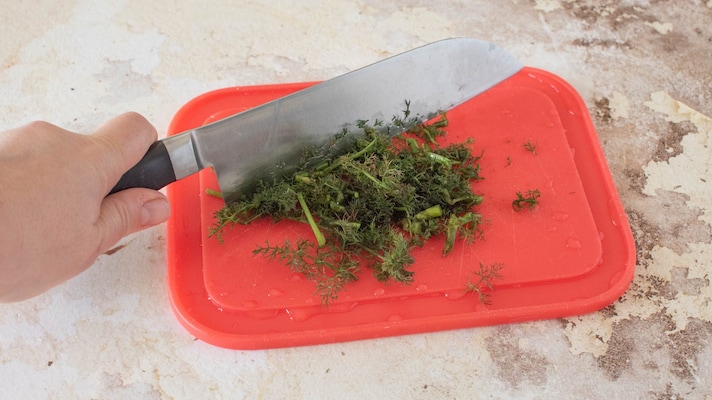
After the indicated time, drain it, keeping the cooking water, and transfer it to a colander, pressing it lightly to eliminate all the water. Add the liquid obtained to the water kept aside, then chop it finely with a knife.
After the indicated time, drain it, keeping the cooking water, and transfer it to a colander, pressing it lightly to eliminate all the water. Add the liquid obtained to the water kept aside, then chop it finely with a knife.
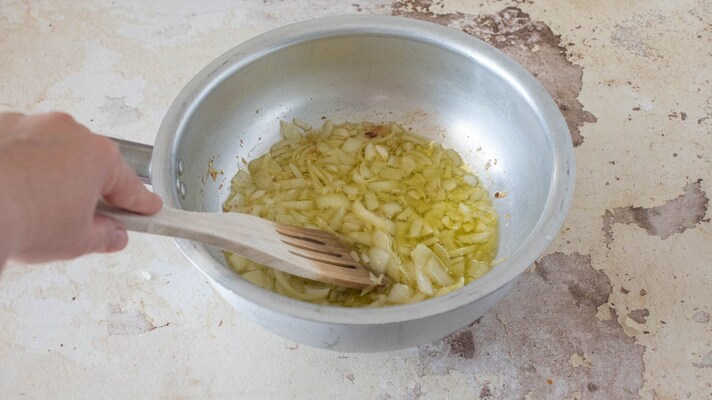
Now roughly chop the onion and sauté it in a pan, over a low heat, with a generous drizzle of oil.
Now roughly chop the onion and sauté it in a pan, over a low heat, with a generous drizzle of oil.
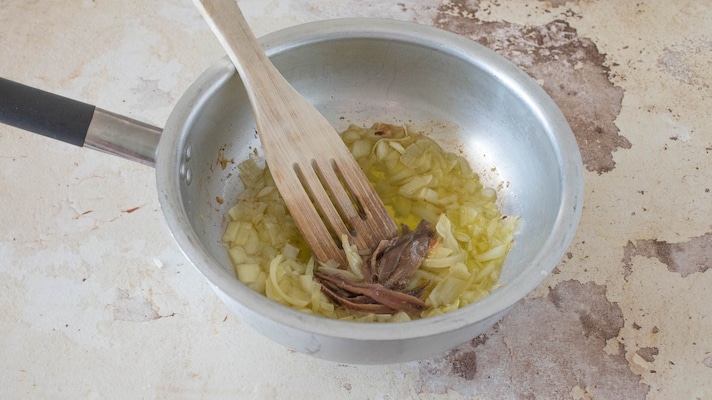
As soon as the onion has softened, add the anchovies in oil and let them melt.
As soon as the onion has softened, add the anchovies in oil and let them melt.
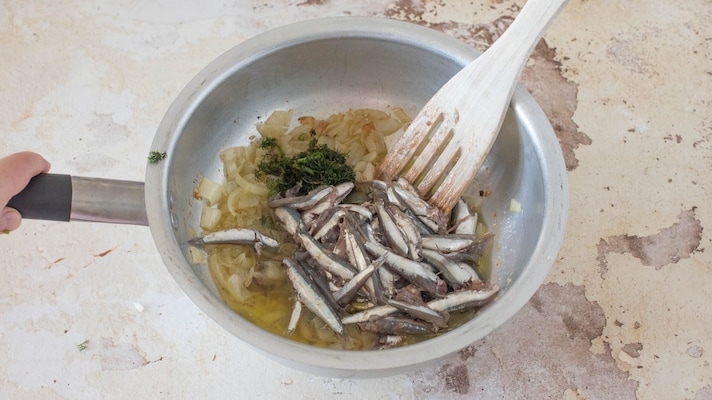
At this point, put the chopped fennel and the cleaned sardines into the pan, keeping 4 aside for the final decoration. Season with salt and pepper and cook for about ten minutes.
At this point, put the chopped fennel and the cleaned sardines into the pan, keeping 4 aside for the final decoration. Season with salt and pepper and cook for about ten minutes.
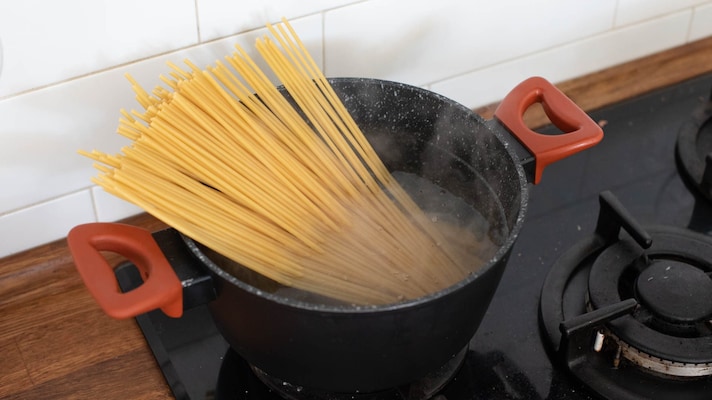
In the meantime, bring the fennel cooking water to the boil, adding a pinch of salt and, if necessary, more water. Then pour in the bucatini and cook them for the cooking time indicated on the package.
In the meantime, bring the fennel cooking water to the boil, adding a pinch of salt and, if necessary, more water. Then pour in the bucatini and cook them for the cooking time indicated on the package.
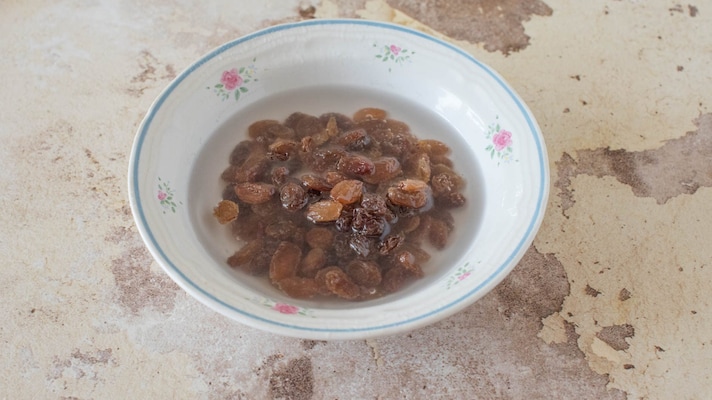
Then soak the raisins in a little water to soften them.
Then soak the raisins in a little water to soften them.
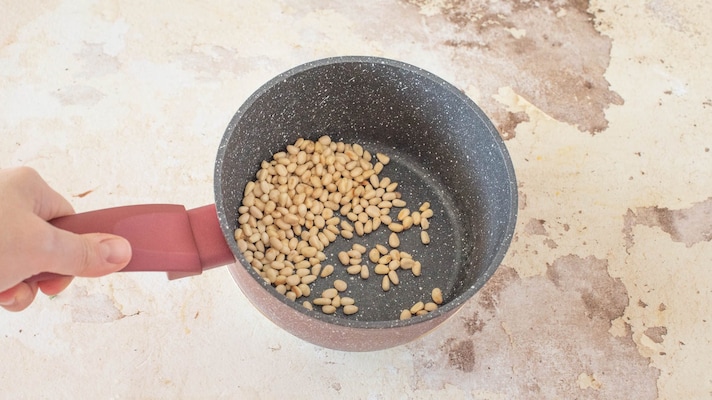
Toast the pine nuts in a non-stick pan, being careful not to let them darken too much.
Toast the pine nuts in a non-stick pan, being careful not to let them darken too much.
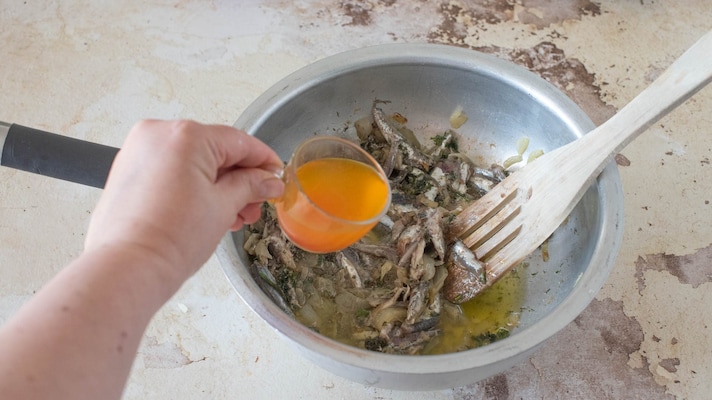
At this point dissolve the saffron in a cup of pasta cooking water and pour it into the pan with the sauce.
At this point dissolve the saffron in a cup of pasta cooking water and pour it into the pan with the sauce.
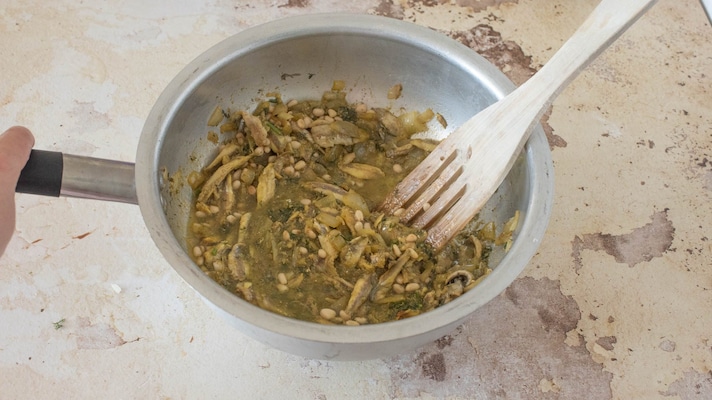
Also add the well-squeezed raisins and the toasted pine nuts and mix to combine everything.
Also add the well-squeezed raisins and the toasted pine nuts and mix to combine everything.
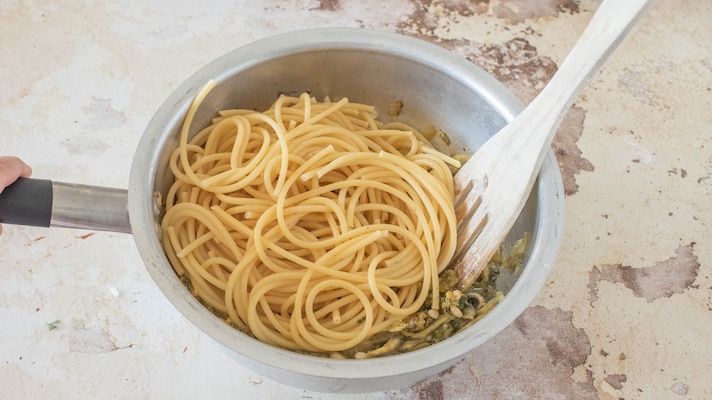
About 2-3 minutes before the end of cooking, drain the bucatini, pour them into the pan with the sauce and stir over a high heat, adding a little cooking water if necessary. Season with salt and pepper.
About 2-3 minutes before the end of cooking, drain the bucatini, pour them into the pan with the sauce and stir over a high heat, adding a little cooking water if necessary. Season with salt and pepper.
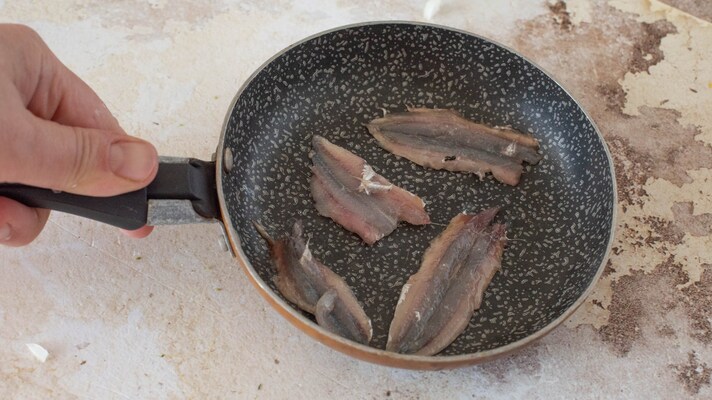
Meanwhile, brown the sardines you kept aside in a non-stick pan with a drizzle of oil.
Meanwhile, brown the sardines you kept aside in a non-stick pan with a drizzle of oil.
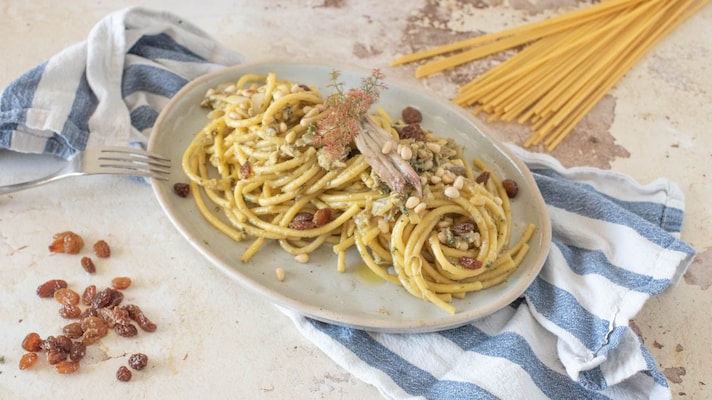
Enjoy it immediately!
Enjoy it immediately!
;Resize,width=767;)
